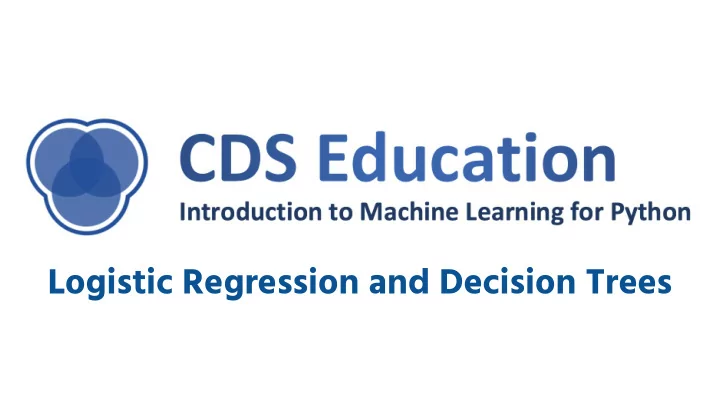

Logistic Regression and Decision Trees
Reminders ● Project Part B was due yesterday ● Project Part C will be released tonight ● Mid-Semester Evaluations ○ Helpful whether you really like the class or really hate it ● Get Pollo - code JYHDQR
Review: Supervised Learning Regression Classification “How much?” “What kind?” Used for continuous predictions Used for discrete predictions Source Source
Review: Regression We want to find a hypothesis that explains the behavior of a continuous y. y = B 0 + B 1 x 1 + … + B p x p + ε Source
Regression for binary outcomes Regression can be used to classify : ● Likelihood of heart disease ● Accept/reject applicants to Cornell Data Science based on affinity to memes Estimate likelihood using regression, convert to binary results Source
Conditional Probability The probability that an event (A) will occur given that some condition (B) is true
Conditional Probability The probability that: ● You have a heart disease given you have x blood pressure, you have diabetes, and you are y years old. ● You are accepted to Cornell Data Science given that you spend x hours a day in the meme fb group
Logistic Regression 1) Fits a linear relationship between the variables 2) Transforms the linear relationship to an estimate function of the probability that the outcome is 1. Basic formula: (Recognize this?)
Pollo Question What is the output of the logistic regression function? A. Value from -∞ to ∞ B. Classification C. Numerical value from 0 to 1 D. Binary value
Pollo Question What is the output of the logistic regression function? A. Value from -∞ to ∞ B. Classification C. Numerical value from 0 to 1 D. Binary value
Sigmoid Function Depending on the regression formula value, P(x) can be between 0 and 1 as x goes from -∞ to ∞. Source
Threshold Where between 0 and 1 do we draw the line? ● P(x) below threshold: predict 0 ● P(x) above threshold: predict 1
Thresholds matter (a lot!) What happens to the specificity when you have a ● Low threshold? ○ Sensitivity increases ● High threshold? ○ Specificity increases Source
ROC Curve R eceiver O perating C haracteristic ● Visualization of trade-off ● Each point corresponds to a specific threshold value
Area Under Curve AUC = ∫ ROC-curve Always between 0.5 and 1. Interpretation: ● 0.5: Worst possible model ● 1: Perfect model
Why Change the Threshold? ● Want to increase either sensitivity or specificity ● Imbalanced class sizes ○ Having very few of one classification skews the probabilities ○ Can also fix with rebalancing classes ● Just a very bad AUC
Changing Thresholds in the Code ● Sklearn uses a default of 0.5 ○ This will be fine a majority of the time ● Have to change the threshold "manually" ○ If the accuracy is low, check the auc ○ If high auc, then use predict_proba ■ Map the probabilities for each class to the label
Is Logistic Regression Classification? ● Partly classification, partly prediction ● Value in logistic regression is the probabilities ○ Have confidence value for each prediction ○ Can act differently based on confidence Source
When to Use Regression ● Works well on (roughly) linearly separable problems ○ Remember SVM kernels for non-linearly separable ● Outputs probabilities for outcomes ● Can lack interpretability , which is an important part of any useful model
CART (Classification and Regression Trees) ● At each node, split on variables ● Each split minimizes error function ● Very interpretable ● Models a non-linear relationship!
Splitting the data = red = gray
How to Grow Trees Greedy Splitting (recursive binary splitting) Check all possible splits using a cost function ● Categorical: try every category ○ Numerical: bin the data ○ Pick the one that minimizes the cost ● Recurse until reached the stopping criterion ● Prune to prevent overfitting ● Source
How to Grow Trees - Cost Function ● Classification and Regression Trees ○ Can be for either classification or regression ● Cost function for regression is the minimizing sum of squared errors ○ Same function
How to Grow Trees - Cost Function Gini Impurity Entropy (Information Gain) ● 1 - probability that guess i ● Homogeneity of a group is correct ● Lower is better ● Lower is better Source
Gini Impurity Example - Good Split ● Probability(Yes) = 0.9 ● Probability(No) = 0.1 Healthy? ● Impurity Yes No = 1 - (0.9^2 + 0.1^2) 9 1 = 0.18
Gini Impurity Example - Bad Split ● Probability(Yes) = 0.5 ● Probability(No) = 0.5 Healthy? ● Impurity Yes No = 1 - (0.5^2 + 0.5^2) 5 5 = 0.5
Entropy Example - Good Split ● Probability(Yes) = 0.9 ● Probability(No) = 0.1 Healthy? ● Entropy Yes No = -0.9*log 0.9 - 0.1*log 0.1 9 1 = 0.14
Entropy Example - Bad Split ● Probability(Yes) = 0.5 ● Probability(No) = 0.5 Healthy? ● Entropy Yes No = -0.5*log 0.5 - 0.5*log 0.5 5 5 = 0.3
How to Grow Trees - Stopping Criterion & Pruning Used to control overfitting of the tree ● Stopping Criterion ○ max_depth, max_leaf_nodes ○ min_samples_split Minimum number of cases needed for a split ■ ● Pruning ○ Compare overall cost with and without each leaf ○ Not currently supported
How to Grow Trees ● Start at the top of the tree ● Split attributes one by one ML Magic Decision ○ Based on cost function ● Assign the values to the leaf nodes ● Repeat ● Prune for overfitting
When to Use Decision Trees ● Easy to interpret ○ Can be visualized ● Requires little data preparation ● Can use a lot of features ● Prone to overfitting
Coming Up Your problem set: Project Part C released Next week: Unsupervised Learning See you then!
Recommend
More recommend